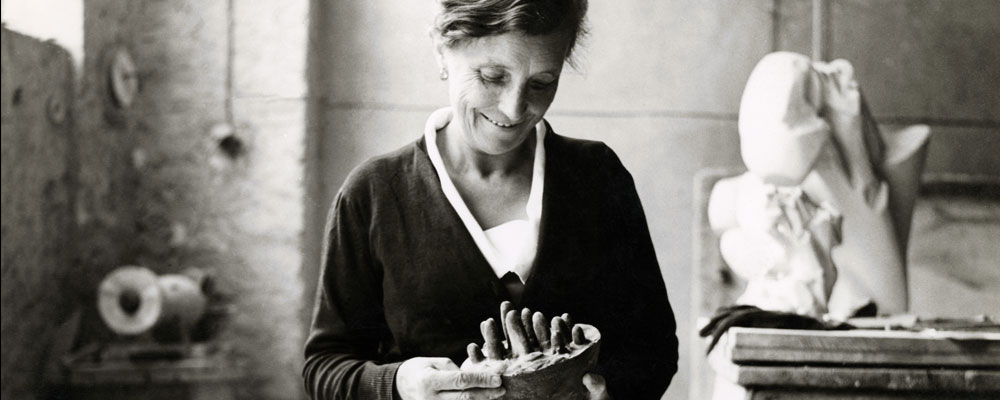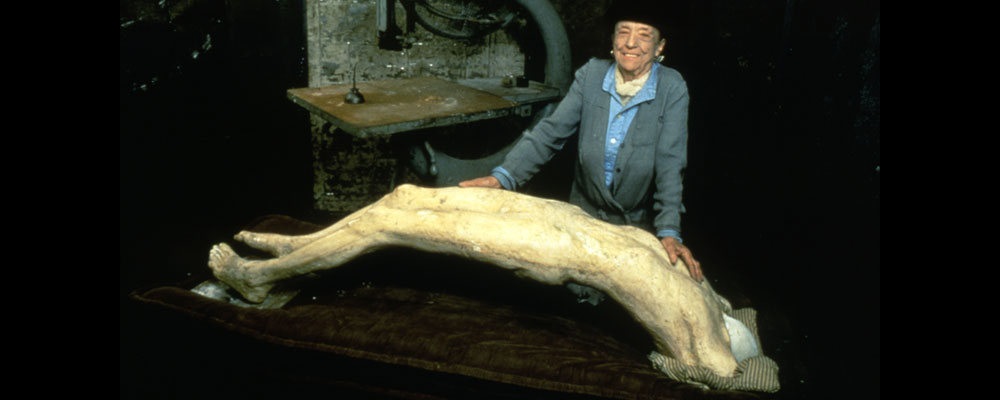Chronology
1911
Louise Joséphine Bourgeois is born in Paris, on December 25th, to Josephine Valerie Fauriaux Bourgeois and Louis Isadore Bourgeois. The family, including her seven-year older sister Henriette Marie Louise, rents an apartment at 172 Boulevard Saint-Germain on the fourth floor. The family has a tapestry gallery at 174 Boulevard Saint-Germain.
1912
The Bourgeois family rents a house in Choisy-le-Roi outside of Paris at 4 Avenue de Villeneuve-St.-Georges, until 1917. The house has a two-story atelier for the tapestry workers. The property extends all the way to the Seine River.
1913
Pierre Joseph Alexandre, Louise's brother, is born.
1915-1918
Her father, Louis Bourgeois, and his brother Desiré are mobilized to fight in World War I. During the war, the Bourgeois family moves temporarily to Aubusson, the home of Louise’s maternal grandparents. Her uncle, Desiré, is killed the first week of the war. Louis Bourgeois is wounded in 1915 and brought to a hospital in Chartres, where Louise and her mother travel to visit him.
1919
The Bourgeois family acquires a property in Antony at 11 Avenue de la Division Leclerc.
1921
Louise attends the Collège Sèvigné and later graduates from the Lycée Fénelon in Paris, 1927.
Just after World War I, Louise's mother Josephine contracts the Spanish flu. Louise’s education is interrupted to care for her mother.
1922
Sadie Gordon Richmond is hired by Louis Bourgeois to teach English to the Bourgeois children. She becomes the his mistress and lives with the family periodically until 1932.
1923
At the age of twelve, Bourgeois is asked to use her drawing skills to help out in the tapestry workshop. She becomes an expert at drawing legs and feet.
The Bourgeois family rents the Villa Marcel in Le Cannet. They spend the winters at Le Cannet and the summers at Antony.
1932
Bourgeois enters the Sorbonne to study calculus and geometry, receiving the Baccalauréate in Philosophy from the University of Paris. Her dissertation is on Blaise Pascal and Emmanuel Kant.
Her mother Joséphine dies on September 14, in Antony.
1933
Bourgeois is depressed by the death of her mother. She abandons the study of mathematics and begins to study art. Over the next several years, she studies in various artists’ ateliers in Montparnasse and Montmartre.
1936-1938
Bourgeois is an assistant or massière at the Académie de la Grande-Chaumière in the studio of Yves Brayer. She also studies under Marcel Gromaire and André Lhote. Bourgeois studies with Fernand Léger (1938) who suggests that her sensibility leans more towards the three dimensional.
1938
Bourgeois partitions off part of her father's tapestry gallery at 174 Boulevard Saint-Germain in order to open up her own art gallery dealing in prints and paintings by Delacroix, Matisse, Redon, Valadon and Bonnard. There she meets Robert Goldwater, an American art historian who is in Paris doing research on his doctoral thesis “Primitivism in Modern Painting”. They marry on September 12th in Paris.
Bourgeois moves to New York City with Robert Goldwater. They live at 63 Park Avenue. Goldwater is an instructor in art history at New York University.
1939
Bourgeois and Goldwater return to France to arrange for the adoption of Michel Olivier, an orphan, who was born in Margaux near Bordeaux in 1936.
1940
Jean-Louis Thomas Bourgeois is born to Louise Bourgeois and Robert Goldwater on July 4th.
1941
Alain Matthew Clement Bourgeois, their third son, is born on November 12th.
1945
Bourgeois has her first solo show, “Paintings by Louise Bourgeois” at the Bertha Schaefer Gallery in New York City.
1947
For her second solo exhibition, Bourgeois exhibits seventeen paintings at Norlyst Gallery in New York City.
1949
“Louise Bourgeois, Recent Work 1947-1949: Seventeen Standing Figures in Wood”, the artist’s first solo exhibition of sculpture is presented at the Peridot Gallery in New York City. Conceived as an environmental installation, it includes Dagger Child (1947-1949), Woman With Packages (1949) and The Blind Leading the Blind (1947-1949).
1950
Bourgeois has a second exhibition, “Louise Bourgeois: Sculptures,” at the Peridot Gallery. Fifteen wooden sculptures are shown, including Persistent Antagonism (1946-1948) and Sleeping Figure (1950).
Robert Goldwater receives a Fulbright Scholarship to study in France.
The family returns to France and lives in Antony. They eventually rent a house at 77 Rue Daguerre in Paris where Bourgeois will have a studio until 1955.
1951
Bourgeois’s father, Louis, passes away on April 9th.
Depressed, Bourgeois begins therapy with Dr. Leonard Cammer and eventually begins psychoanalysis with Dr. Henry Lowenfeld. Her intense analysis is from 1952-1967, but she continues to see Lowenfeld until his death in 1985.
1953
Bourgeois has her third and last solo show at the Peridot Gallery entitled “Louise Bourgeois: Drawings for Sculpture and Sculpture” which includes Foret (Night Garden) (1953).
1955
Bourgeois becomes an American citizen.
1957
In 1957, Robert Goldwater is hired as a Professor of Art History at the Institute of Fine Arts, New York University.
1960
Bourgeois starts experimenting with organic materials, such as plastic, latex and rubber.
Bourgeois’s brother Pierre dies.
1964
After a hiatus of eleven years, Bourgeois exhibits a new body of work, “Louise Bourgeois: Recent Sculpture”, at the Stable Gallery. She exhibits Clutching (1962), Labyrinthine Tower (1962), Lair (1962-1963), Rondeau for L (1963) and Fée Couturière (1963). The Rose Fried Gallery simultaneously presents a solo show of works on paper, "Recent Drawings by Louise Bourgeois".
1966
Lucy Lippard organizes the exhibition “Eccentric Abstraction” at the Fischbach Gallery in New York City. Her work is shown with a younger generation of artists such as Eva Hesse and Bruce Nauman.
1967-1968
Bourgeois makes her first trip to Pietrasanta, Italy to work in marble and bronze. She makes Germinal (1967) and the Janus series (1968) in bronze. In marble, she realizes Sleep II (1967) and Cumul I (1969). She will continue to return regularly to Pietrasanta through 1972.
Bourgeois becomes active in political and feminist events. Her work, such as Le Regard (1966), Fillette (1968) and Femme Couteau (1969-1970), become more sexually explicit.
1973
Bourgeois’s husband Robert Goldwater dies on March 26th.
1974
Bourgeois exhibits at the alternative space called 112 Greene Street. Entitled “Louise Bourgeois: Sculpture 1970-1974,” it includes Labyrinthine Tower (1962), the hanging Janus series (1968) in bronze, and the installation The Destruction of the Father (1974).
1978
Bourgeois exhibits the installation Confrontation (1978) at the Hamilton Gallery of Contemporary Art in New York City. Her performance, “A Banquet: A Fashion Show of Body Parts”, is presented inside the installation where models parade while wearing latex costumes.
1980
“The Iconography of Louise Bourgeois” is curated by Jerry Gorovoy at Max Hutchinson Gallery in New York. The exhibition includes early prints, drawings and paintings, including the four Femme Maison (1945-1947) paintings.
Bourgeois’s older sister, Henriette, dies on July 9th.
1982
“Louise Bourgeois: Retrospective” opens at the Museum of Modern Art in New York City. The exhibition, curated by Deborah Wye, is the first retrospective given to a woman artist at the museum. The show travels to the Contemporary Arts Museum in Houston, the Museum of Contemporary Art in Chicago, and the Akron Art Museum in Ohio.
Bourgeois makes a slide presentation called “Partial Recall” that recounts the story of her early family life, to accompany the MoMA exhibition. For Artforum, Bourgeois will create a layout excerpted from “Partial Recall” that tells the story of her English tutor Sadie Gordon Richmond’s relationship with her father.
1989
Organized by Peter Weiermair, Bourgeois has her first European Retrospective at the
Frankfurter Kunstverein, “Louise Bourgeois: A Retrospective Exhibition.” The show travels to the Stadtische Galerie im Lenbachhaus in Munich, the Musée d'Art Contemporain in Lyon, the Fundación Tapies in Barcelona, the Kunstmuseum in Bern and the Kröller-Muller Museum in Otterlo.
1990
Bourgeois’s son Michel passes away.
1993
Bourgeois represents the United States at the American Pavilion of the Venice Biennale.
1995
The MARCO in Monterrey, Mexico mounts “Louise Bourgeois” which travels to the Centro Andaluz de Arte Contemporaneo in Seville, and to the Museo Rufino Tamayo in Mexico City.
1996
Bourgeois is included in the Sao Paulo Bienal, curated by Paulo Herkenhoff and Jerry Gorovoy.
1997
Violette Editions in London publishes Louise Bourgeois: Destruction of the Father / Reconstruction of the Father (Writings and Interviews 1923-1997), edited and with texts by Marie-Laure Bernadac and Hans-Ulrich Obrist.
The National Medal of Arts is presented to Bourgeois by President Clinton at the White House. Her son Jean-Louis Bourgeois accepts the award on her behalf.
1999
Curated by Jerry Gorovoy and Danielle Tilkin, the Museo Nacional Centro de Arte / Reina Sofia in Madrid mounts the Retrospective exhibition “Louise Bourgeois: Architecture and Memory”.
2000
Bourgeois is commissioned for the inaugural installation at Turbine Hall of Bankside Power Station, opening as the new Tate Gallery of Modern Art. Bourgeois displays a thirty foot steel and marble Spider called Maman (1999) and three steel architectural towers called I Do, I Undo and I Redo (1999-2000) that employ the use of staircases and mirrors and incorporate fabric and marble sculptures within the interiors.
2001
The Guggenheim Museum Bilbao purchases the thirty foot bronze, stainless steel and marble Spider Maman (1999) and installs it outside of their titanium paneled building designed by Frank Gehry.
2007-2009
The Tate Modern in London organizes a Bourgeois Retrospective in collaboration with the Centre Georges Pompidou in Paris The exhibition travels to the Solomon R. Guggenheim Museum in New York, the Museum of Contemporary Art in Los Angeles, and the Hirshhorn Museum & Sculpture Garden, Washington DC.
2008
The French Legion of Honor medal is presented by President Sarkozy to Louise Bourgeois at artist’s Chelsea home.
2010
Louise Bourgeois dies on May 31st.
2011
Curated by Philip Larratt-Smith, “Louise Bourgeois: The Return of the Repressed” presents the first in-depth examination of Bourgeois’s relationship to psychoanalysis
and art. The exhibition is organized by the Fundación Proa in Buenos Aires and the Instituto Tomie Ohtake in Sao Paulo and also travels to the Museu de Arte Moderna in Rio de Janeiro.

